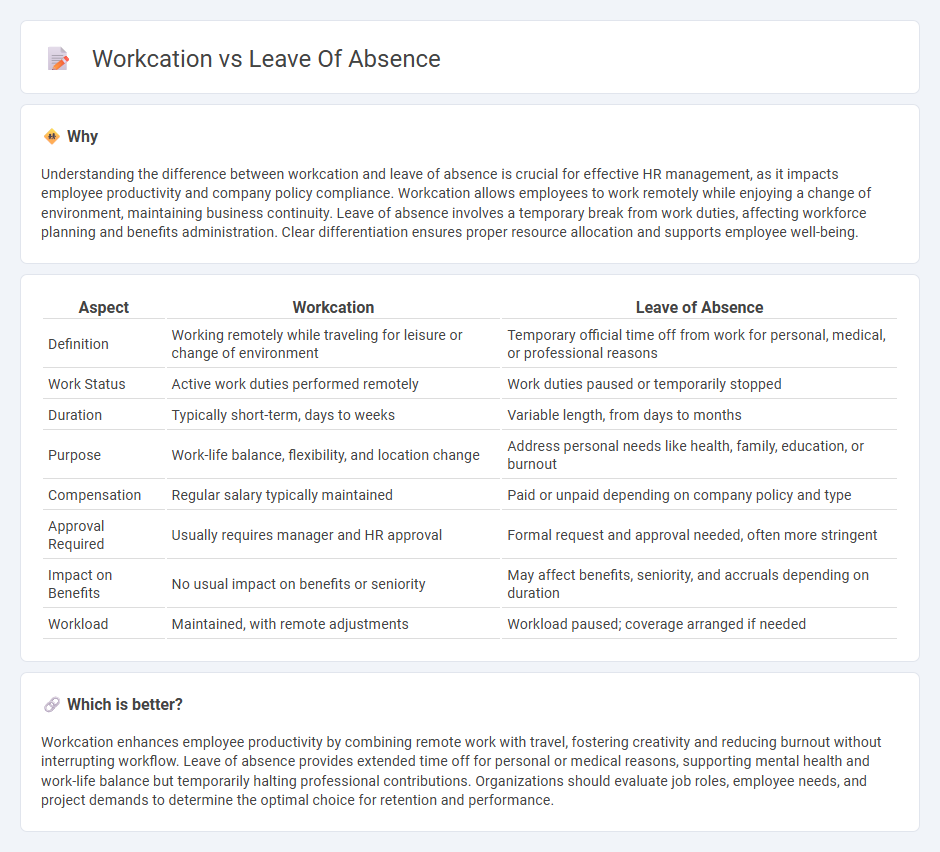
Workcation combines remote work with leisure, allowing employees to maintain productivity while exploring new environments, contrasting with a leave of absence which involves a temporary break from work duties for personal or medical reasons. Companies adopting flexible policies on workcation report increased employee satisfaction and retention rates, highlighting its role in modern workforce management. Discover how integrating workcation strategies can transform your organization's approach to employee well-being and engagement.
Why it is important
Understanding the difference between workcation and leave of absence is crucial for effective HR management, as it impacts employee productivity and company policy compliance. Workcation allows employees to work remotely while enjoying a change of environment, maintaining business continuity. Leave of absence involves a temporary break from work duties, affecting workforce planning and benefits administration. Clear differentiation ensures proper resource allocation and supports employee well-being.
Comparison Table
| Aspect | Workcation | Leave of Absence |
|---|---|---|
| Definition | Working remotely while traveling for leisure or change of environment | Temporary official time off from work for personal, medical, or professional reasons |
| Work Status | Active work duties performed remotely | Work duties paused or temporarily stopped |
| Duration | Typically short-term, days to weeks | Variable length, from days to months |
| Purpose | Work-life balance, flexibility, and location change | Address personal needs like health, family, education, or burnout |
| Compensation | Regular salary typically maintained | Paid or unpaid depending on company policy and type |
| Approval Required | Usually requires manager and HR approval | Formal request and approval needed, often more stringent |
| Impact on Benefits | No usual impact on benefits or seniority | May affect benefits, seniority, and accruals depending on duration |
| Workload | Maintained, with remote adjustments | Workload paused; coverage arranged if needed |
Which is better?
Workcation enhances employee productivity by combining remote work with travel, fostering creativity and reducing burnout without interrupting workflow. Leave of absence provides extended time off for personal or medical reasons, supporting mental health and work-life balance but temporarily halting professional contributions. Organizations should evaluate job roles, employee needs, and project demands to determine the optimal choice for retention and performance.
Connection
Workcation and leave of absence both provide employees with opportunities to step away from their regular work routines, promoting mental health and productivity. Workcation allows employees to work remotely from a different location, blending leisure and work, while leave of absence offers an extended break for personal or health reasons without job loss. Integrating workcation options can reduce the need for prolonged leaves, supporting employee well-being and retention in human resources management.
Key Terms
Paid Time Off (PTO)
Paid Time Off (PTO) typically covers leave of absence scenarios, allowing employees to take uninterrupted time off for personal or health reasons while maintaining salary benefits. In contrast, a workcation involves working remotely from a vacation location, blending work duties with leisure, which usually requires utilizing PTO differently or not at all. Explore how both options impact your PTO balance and work-life balance to choose the best fit for your needs.
Remote Work
A leave of absence typically involves taking unpaid or paid time off from work for personal reasons, health, or extended travel, during which employees are not expected to perform job duties. A workcation blends remote work with leisure, allowing employees to maintain productivity while working from a vacation-like setting, leveraging technology and flexible schedules. Explore more about how remote work strategies can balance productivity and relaxation in diverse environments.
FMLA (Family and Medical Leave Act)
The Family and Medical Leave Act (FMLA) provides eligible employees with up to 12 weeks of unpaid, job-protected leave for specified family and medical reasons, ensuring job security and continuation of health benefits during absences related to serious health conditions or family care. A leave of absence under FMLA differs from a workcation, where employees temporarily work remotely in a different location without taking unpaid leave, thus maintaining regular work duties and pay. Understanding how FMLA leave rights apply can help employees and employers navigate proper leave options; learn more about FMLA compliance and work-life balance strategies.
Source and External Links
What employers need to know about employee leave of absence - A leave of absence allows employees to take time off for special circumstances, with mandatory types governed by laws like the FMLA providing up to 12 weeks of unpaid job-protected leave for qualifying reasons such as serious health conditions or family care.
What is the Leave of Absence Laws in California? - Eldessouky Law - In California, qualified employees can take up to 12 weeks of unpaid leave (or longer if necessary) for personal health issues, family care, or bonding with a child, with laws in place to protect employees from discrimination or termination for taking leave.
What Is a Leave of Absence? Meaning & Types - Velocity Global - A leave of absence is a formal arrangement enabling employees to temporarily step away from work without losing their job, which can be paid or unpaid, and is often legally required to accommodate significant life events such as illness, childbirth, or family emergencies.
 dowidth.com
dowidth.com